Examples of Conversational Commerce, Chatbots & Contextual Commerce
Advances in AI combined with the rising popularity of mobile messaging apps are sparking new wave of innovation in digital commerce which is more conversational and more personal in nature.
Messaging apps such as WeChat, WhatsApp, and Facebook Messenger have become the preferred means of communication on mobile devices, with messaging apps surpassing social apps in global popularity as of Q2 2015.
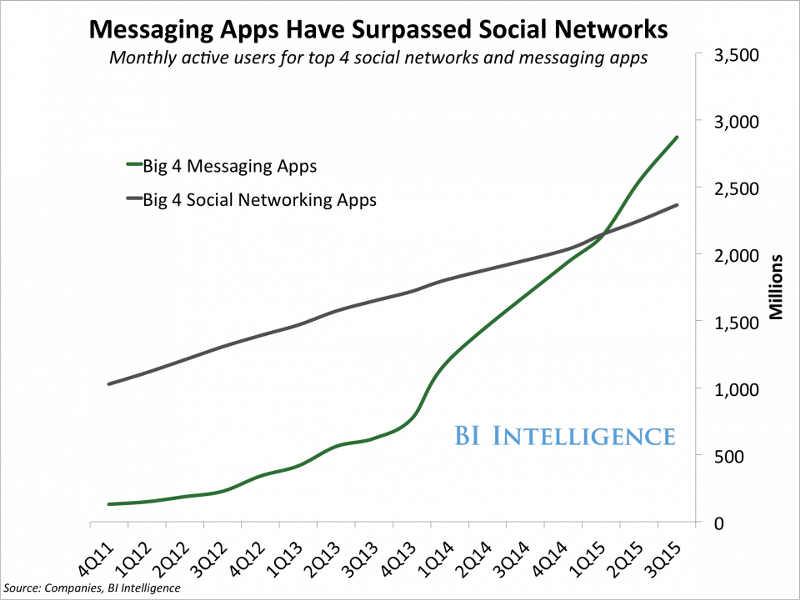
At the same time, advances in artificial intelligence are enabling companies to combine live support staff with automated bots to create compelling and cost-effective chat-based interaction systems for their customers. AI technology has also advanced to the point where voice digital assistants are beginning to become useful for the average consumer.
Brands have realized the immense opportunity in creating more personal, conversational experiences for interacting with customers and exposing these through a variety of platforms — and thus a new trend dubbed by Chris Messina as “conversational commerce” began to pick up speed in 2015.
From my perspective, conversational commerce involves brands interacting with their customers through a messaging app or voice-based UI, sometimes combined with a visual UI to present product images or options, to provide a more natural, conversational, almost concierge-like experience, vs the traditional paradigm of providing a click/tap-based website or app to provide information and functionality.
During the course of our work at ZipfWorks building community-centric shopping apps, we pay close attention to emerging trends in e-commerce. This list is what we see as the currently most interesting and potentially consequential examples of conversational commerce.
“If you can get ahold of Facebook’s product roadmap, it’s a giant WeChat clone.” — William Bao Bean, SOS Ventures and Chinaccelerator
WeChat was created by Chinese holding company Tencent three years ago. The product was created by a special projects team within Tencent (who also owns the dominant desktop messaging software in China, QQ) under the mandate of creating a completely new mobile-first messaging experience for the Chinese market. In three short years, WeChat has exploded in popularity and has become the dominant mobile messaging platform in China, with approximately 700M monthly active users (MAUs).
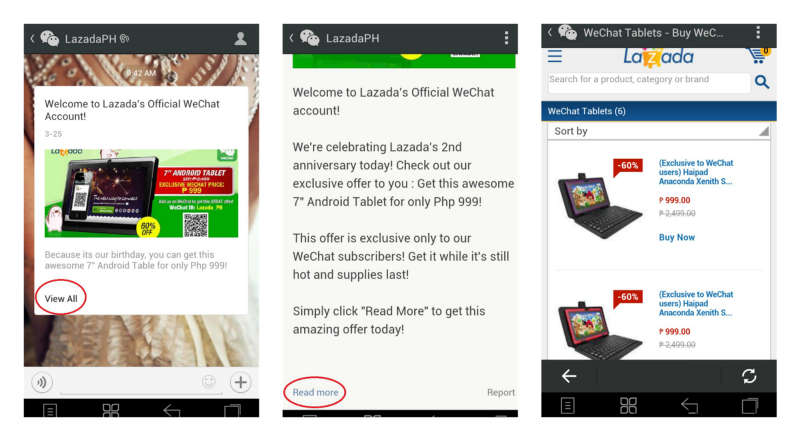 How stores interact with customers on WeChat
How stores interact with customers on WeChat
WeChat is different from most mobile apps that Western observers may be familiar with in that it condenses a massive number of features into a single app. In the US, the trend is quite the opposite, with increasingly specific, single-purpose apps becoming the norm. On WeChat users can:
- Create and send stickers
- Hail a taxi
- Order food delivery
- Buy movie tickets
- Customize and order a pair of Nikes
- Send an order to the nearest Starbucks
- Track your daily fitness progress
- Shop Burberry’s latest collection
- Meet strangers near you
- Book doctor’s appointments
- Host a business conference call
- Read the news
- Pay your water bill
You get the point.
“They’re doing things we’re simply not doing in the U.S. Imagine if you were going to start a city from scratch. Rather than having to deal with all the infrastructure created 200 years ago, you could hit the ground running on the latest technology. That’s what China’s doing — they’re accessing markets for the first time through mobile apps and payments.” — Brian Buchwald, CEO of consumer intelligence firm Bomoda
WeChat has become an e-commerce powerhouse due to its rich API functionality provided to business accounts. Businesses can create free accounts on WeChat and immediately begin connecting with customers. Consumers create connections with businesses, who can then broadcast messages to its customers, setup e-commerce storefronts, and conduct chat conversations, and even promote and sell products directly within those chat conversations (users just have to say “I want it” to buy).
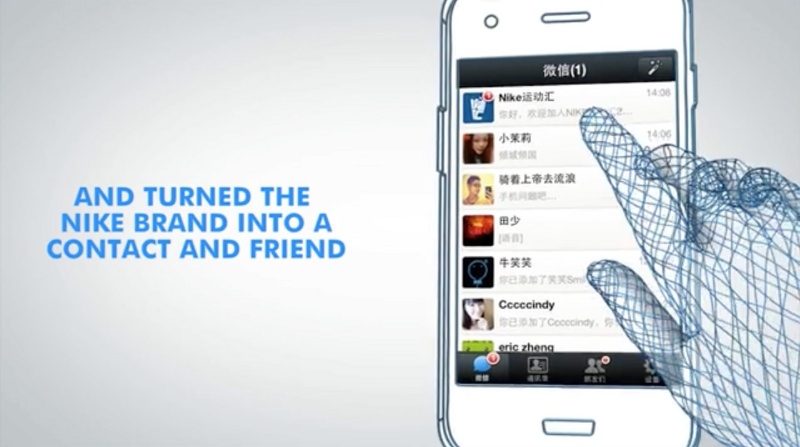 Nike’s social media presence on WeChat
Nike’s social media presence on WeChat
Over 10 million businesses are on WeChat, including brands like Nike and Burberry. There is an enormous amount of experimentation and innovation in creating new, conversational and direct ways of interacting with customers on WeChat, and US companies (in particular Facebook) are taking note.
Facebook Messenger
“I don’t know anyone who likes calling a business. And no one wants to have to install a new app for every business or service that they interact with. We think you should be able to message a business, in the same way you would message a friend.” — Mark Zuckerberg at F8 in 2016.
Facebook has jumped fully on the conversational commerce bandwagon and is betting big that it can turn its popular Messenger app into a business messaging powerhouse. The company first integrated peer-to-peer payments into Messenger in 2015, and then launched a full chatbot API so businesses can create interactions for customers to occur within the Facebook Messenger app. You can order flowers from 1–800-Flowers, browse the latest fashion and make purchases from Spring, and order an Uber, all from within a Messenger chat.
“We’re just getting people used to the idea that you can message more than just people on Messenger.” — Facebook Messenger product manager Seth Rosenberg.
 You can now order an Uber by selecting the “Request a Ride” option within Facebook Messenger
You can now order an Uber by selecting the “Request a Ride” option within Facebook Messenger
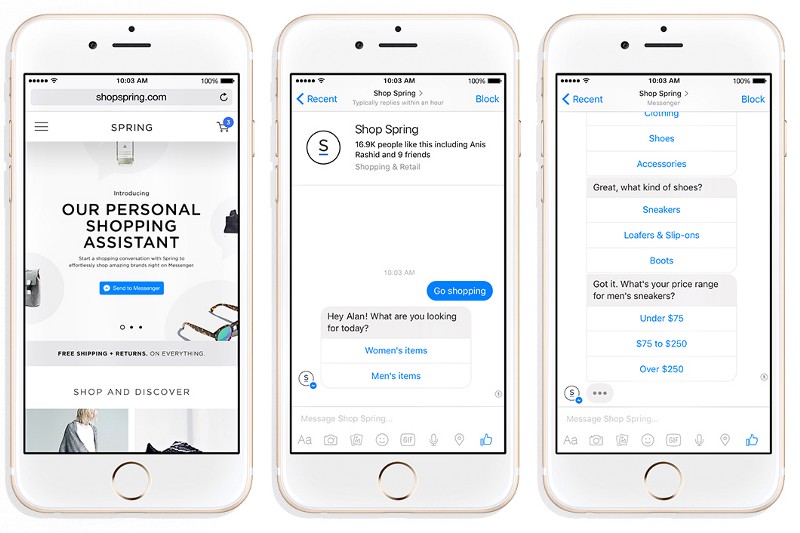 Shopping for fashion with Spring’s bot on Facebook Messenger
Shopping for fashion with Spring’s bot on Facebook Messenger
The Facebook Messenger API enables rich interactive UI elements to be included as a part of chats, which I think points to a future of conversational UIs that are not limited to text chats or voice commands, but which weave together maps, product photos, comparison tools, and other interactive elements (cards?) into the conversation stream.
Amazon Echo
“Alexa, I’m hungry.”
Amazon’s Echo device has been a surprise hit, reaching over 3M units sold in less than 18 months. Although part of this success can be attributed to the massive awareness-building power of the Amazon.com homepage, the device receives positive reviews from customers and experts alike, and has even prompted Google to develop its own version of the same device, Google Home.
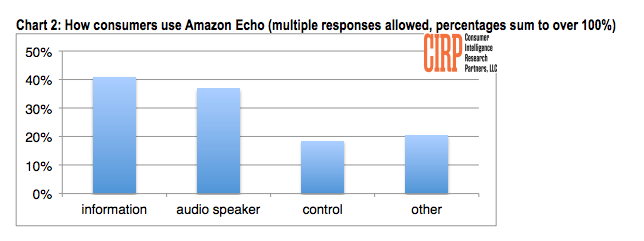
What does the Echo have to do with conversational commerce? While the most common use of the device include playing music, making informational queries, and controlling home devices, Alexa (the device’s default addressable name) can also tap into Amazon’s full product catalog as well as your order history and intelligently carry out commands to buy stuff. You can re-order commonly ordered items, or even have Alexa walk you through some options in purchasing something you’ve never ordered before.
Through Amazon’s developer platform for the Echo (called Alexa Skills), developers can develop “skills” for Alexa which enable her to carry out new types of tasks. Examples of skills include playing music from your Spotify library, adding events to your Google Calendar, or querying your credit card balance with Capital One — you can even ask Alexa to “open Dominoes and place my Easy Order” and have pizza delivered without even picking up your smartphone. Now that’s conversational commerce in action.
Operator
Operator calls itself a “request network” aiming to “unlock the 90% of commerce that’s not on the internet.” The Operator app, developed by Uber co-founder Garrett Camp, connects you with a network of “operators” who act like concierges who can execute any shopping-related request. You can order concert tickets, get gift ideas, or even get interior design recommendations for new furniture. Operator seems to be positioning itself towards “high consideration” purchases, bigger ticket purchases requiring more research and expertise, where its operators can add significant value to a transaction.
 Examples of commerce interactions on Operator
Examples of commerce interactions on Operator
Operator’s agents are a mix of Operator employees, in-store reps, and brand reps. The company is also developing artificial intelligence to help route requests. No doubt the service will become smarter over time, combining machine learning for efficiency and human expertise for quality recommendations.
Slack
Slack has its own internal help bot (@slackbot) which sends you occasional helpful messages which you could then interact with using text chat commands. The company has expanded on this concept and launched an external API enabling developers to build their bots for Slack, accessible via Slack’s app directory.
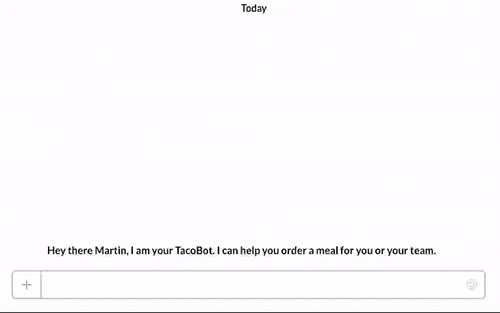 Ordering with TacoBot on Slack
Ordering with TacoBot on Slack
One of the more talked about integrations has been Taco Bell‘s announcement that it is working on a Slackbot (appropriately named Tacobot) which will not only take your Gordita Supreme order but will do it with the same “witty personality you’d expect from Taco Bell.” Consumer demand for such a service remains to be seen, but it points to possibilities of future commerce integrations into Slack.
Allo from Google
At this year’s I/O, Google announced its own Facebook Messenger competitor called Allo. Apart from some neat features around privacy and self-expression, the really interesting part of Allo is @google, the app’s AI digital assistant. Google’s assistant is interesting because the company has about a decades-long head start in machine learning applied to search, so its likely that Allo’s chatbot will be very useful. In fact, you could see Allo becoming the primary interface for interacting with Google search over time. This interaction model would more closely resemble Larry Page’s long-term vision for search, which goes far beyond the clumsy search query + results page model of today:
“In many ways, we’re a million miles away from creating the search engine of my dreams, one that gets you just the right information at the exact moment you need it with almost no effort,” — Larry Page
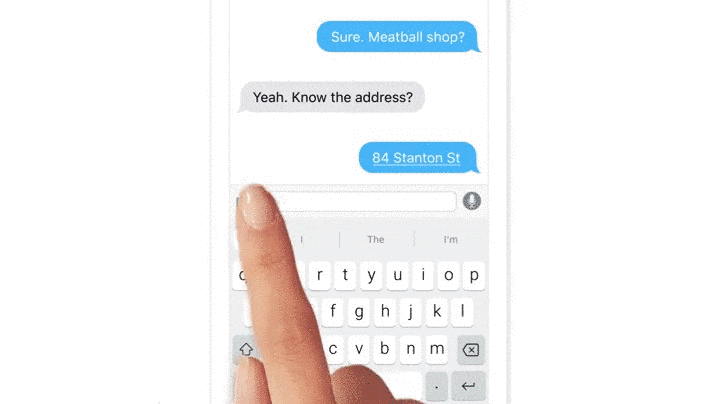 Allo from Google
Allo from Google
Through Knowledge Graph, Google search has already become amazingly good at understanding the context and meaning of your queries, and these queries will likely become more similar to natural language over time. With its massive scale in data and years of working at the very hard problems of natural language processing, the company has a clear path to making Allo’s conversational commerce capabilities second to none.
Snapchat Discover + Snapcash
Brands are falling over themselves to get onto Snapchat, and the ultra-popular messaging app among teens and Millennials has recently been offering some tantalizing signs that it will be offering enhanced tools for marketers in the near future.
In 2015, Snapchat launched Snapcash, a virtual wallet which allows users to store their debit card on Snapchat and send money between friends with a simple message.
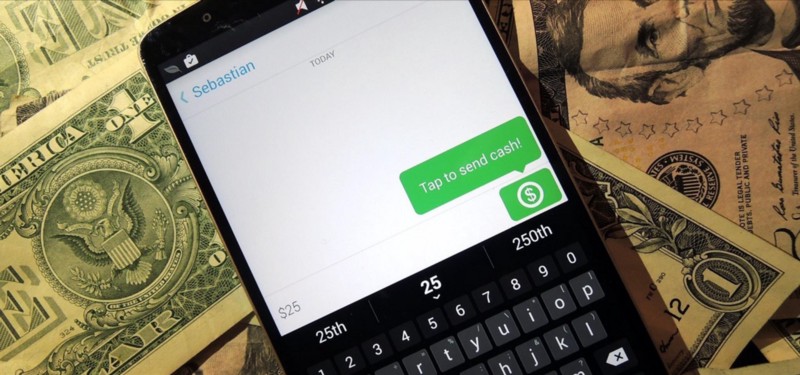 Snapcash on Snapchat
Snapcash on Snapchat
With competitor Venmo already established, peer-to-peer payments is not in and of itself a compelling feature for Snapchat. However, adding wallet functionality and payment methods to the app does lay the groundwork for Snapchat to delve directly into commerce. The messaging app’s commerce strategy became more clear in April 2016 with its launch of shoppable stories with select partners in its Discover section. For the first time, while viewing video stories from Target and Lancome, users were able to “swipe up” to visit an e-commerce page embedded within the Snapchat app where they could purchase products from those partners.
While this was a limited test, it shows that Snapchat sees potential in enabling direct commerce (likely fulfilled through Snapcash payments) within the Snapchat app, opening the door to many interesting new ways to brands to interact and sell products to Snapchatters.
 Lancome on Snapchat Discover
Lancome on Snapchat Discover
While snaps and stories are a bit different from traditional voice or chat conversations, Snapchat nonetheless represents a new form of messaging which enables entirely new ways to embed commerce into conversations, and with 10B views per day, innovation on Snapchat will no doubt be exciting and will have a profound impact on commerce.
AppleTV and Siri
With last year’s refresh of AppleTV, Apple brought its Siri voice assistant to the center of the UI. You can now ask Siri to play your favorite TV shows, check the weather, search for and buy specific types of movies, and a variety of other specific tasks. Although far behind Amazon’s Echo in terms of breadth of functionality, Apple will no doubt expand Siri’s integration into AppleTV, and its likely that the company will introduce a new version of AppleTV that more directly competes with the Echo, perhaps with a voice remote control that is always listening for commands.
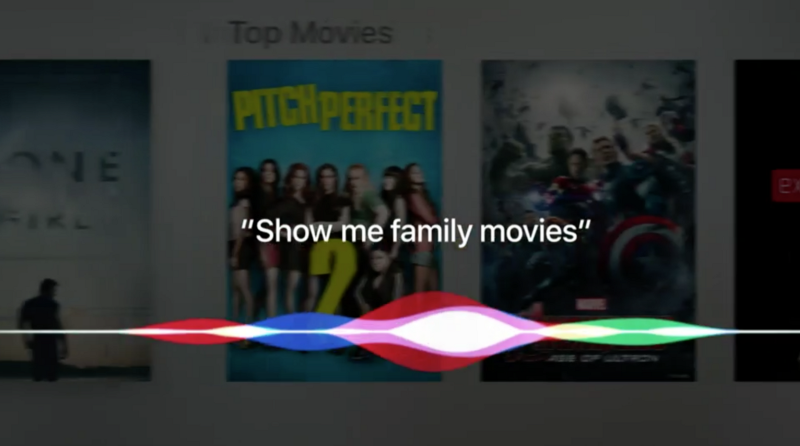
While AppleTV’s commerce capabilities are currently limited to purchasing media from iTunes, it seems likely that Siri’s capabilities would be extended to tvOS apps so app developers will be able to support voice commands from AppleTV directly within their apps. Imagine using voice commands to navigate through Netflix, browse the your Fancy shopping feed, or plan a trip using Tripadvisor on AppleTV — the potential for app developers will be significant if Apple extends its developer platform further into the home through AppleTV and Siri.
Magic
Magic is perhaps the first service that popularized the idea of an all-in-one intelligent virtual assistant as a service. Unique in that the service does not even have an app (you access is purely via SMS), Magic promises to be able to handle virtually any task you send it — almost like a human executive assistant. Based on user and press accounts, Magic seems to be able to successfully carry out a variety of odd tasks from setting up flight reservations to ordering hard-to-find food items.
 Examples of things Magic can do
Examples of things Magic can do
However, since Magic simply connects you with human operators who carry our your requests, the service does not leverage AI to automate its processes, and thus the service is expensive and thus may lack mainstream potential. The company recently launched a premium service called Magic+ which gets you higher level service for $100 per hour, indicating that it sees its market among business executives and other wealthy customers.
Kik Bots In Kik CEO Ted Livingston’s vision of the future, you may sit down at a baseball game, open your Kik app, and scan a QR-type code on the seat in front of you to chat with the stadium’s concierge to order a beer delivered to your seat. In his words:
“Chat is going to be the next great operating system. Apps will come to be thought of as the new browsers; bots will be the new websites. This is the beginning of a new internet.”
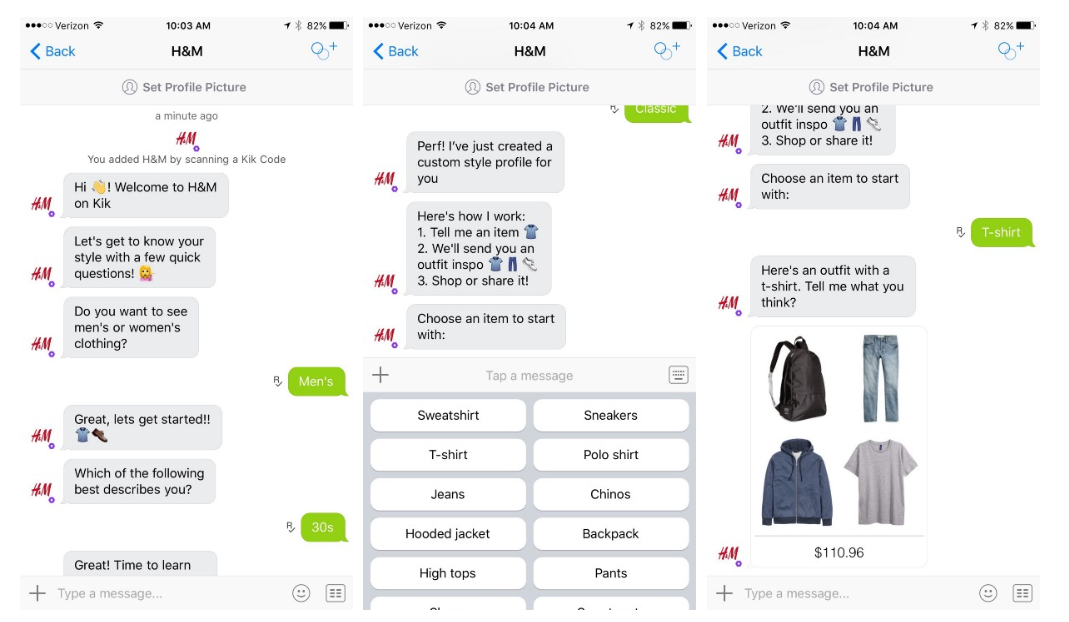 Shopping H&M via its Kik bot
Shopping H&M via its Kik bot
Kik is one of the most popular chat apps among teens with 275M MAUs and 40% of those are in the 13–24 year old demographic. In April, Kik launched its own bot store with 16 launch partners including Sephora, H&M, Vine, the Weather Channel, and Funny or Die. Using Kik’s bots currently feel like using the internet in 1994, very rough around the edges and limited functionality / usefulness. However, we’ll see how their API and bots progress over time, Kik’s popularity among an attractive demographic might convince some brands to invest in the platform.
Telegram
Founded by Pavel Durov, creator of Russia’s equivalent to Facebook, Telegram launched in 2013 as a lightweight messaging app to combine the speed of WhatsApp with the ephemerality of Snapchat along with claimed enhanced privacy and security through its use of the MTProto protocol (Telegram has offered a $200k prize to any developer who can crack MTProto’s security). Telegram has 100M MAUs, putting it in the second tier of messaging apps in terms of popularity.
 Example of a Telegram Messenger bot in action
Example of a Telegram Messenger bot in action
Telegram launched its bot API in 2015, and launched version 2.0 of its platform in April 2016, adding support for bots to send rich media and access geolocation services. As with Kik, Telegram’s bots feel spartan and lack compelling features at this point, but that could change over time. Telegram has also yet to add payment features, so there are not yet any shopping-related bots on the platform.
What do you think?
This is not intended to be a comprehensive list of conversational commerce examples — rather I wanted to highlight some of the more interesting examples. If I’ve missed anything or if you have any thoughts to add, please let me know and I’ll be happy to update this list.

